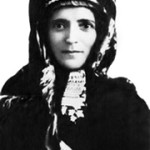Why I wrote “Prelude to Genocide: Incident in Erzerum”
My father told us three stories learned from his mother: first, how she’d been nailed into a box and smuggled from eastern Turkey into Russia after the Armenian massacres of 1895 – she always wept, he said, in recounting her family’s escape – and second, that she’d lived with her husband and his brothers in their parents’ home. At times, that household included as many as 40 adults and children.
She also recounted that the family was saved during the massacre in Erzerum by their close friend, a Muslim Army captain who lived next door. Yet my father, born three years later, was named for an uncle killed in that massacre. This puzzling fact creates the central mystery as Prelude to Genocide: Incident in Erzerum unfolds.
A second cousin, born in Erzerum, survived the great Armenian Massacre of 1915 and the subsequent famine, with her sister and mother. At age 19, Zevart left an orphanage in Smyrna to marry an Armenian-American who brought her to this country. She and Joe raised their family in Brooklyn, and through careful saving, brought her mother, sister and an aunt to live down the street. Years later, when my own family moved to Brooklyn, my father sought out compatriots at the Armenian Apostolic Church. Zevart called him upon learning from a church friend that a man with her family name was now residing nearby.
Zevart and Joe became caring friends to my parents, brother and me, sympathetic to our need for family. With warm affection, they included us in many family celebrations ringing with Armenian song, dance and language. One son played the oud, an instrument similar to the Russian balalaika. My father happily shifted from his accented English, but he did not encourage us to pick up Armenian from them. He saw no point in having his children learn the language of a tiny country.
Zevart Kolligian became a priceless source of information about life in Erzerum and the customs of Armenian Christians there and here. I visited my aunt Zevart many times during the long years of research and writing that preceded publication in 2015. She invariably welcomed me with a fresh baked meal of her boreg, roast chicken and stewed green beans, along with tea and cookies.
My aunt Zevart generously loaned me her English-language copy of a book about life in Garin, an alternative name for Erzerum, as remembered by Armenian survivors. The book was published by the Garin Compatriotic Union of the United States in 1975 in a limited edition of only 100 copies; I tried to find the book without success until 2015, when an Internet-savvy librarian located a copy through a dealer on the west coast. I was both astonished and happy to claim it — and to finally return Zevart’s book to her daughter Louise.
That book has been tremendously useful to me in portraying life for Erzerum Armenians in 1895, with its chapters on language, proverbs, songs, customs, religions, education, marriage, civic life, prominent citizens, literature, libraries, political parties and other aspects of life as remembered in Erzerum before the 1915 Genocide.
My father’s recollections of his boyhood in Kars helped me develop the character traits of his parents, grandparents and other family members. His father’s harsh discipline, his mother’s generosity to beggars and rivalry among siblings reappear in the earlier family household. A remarkable horse given to him as a young soldier by a departing English officer now belongs to the Muslim friend who plays a central role in the novel. The Armenian Apostolic Bishop who was a family friend in Kars became the family friend and Bishop in Erzerum; the historic fact of Bishop Shishmanian’s exile from Erzerum for an indiscreet letter was woven into the story.
The rich world of these stories inspired me to write the book; I required many other sources to understand enough about life in eastern Turkey in the 1890s to write Prelude to Genocide: Incident in Erzerum.

Leave a Comment